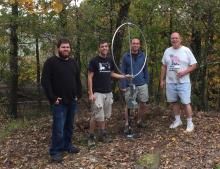New RBN Receivers in New Jersey
New RBN Receivers in New Jersey

On October 19 – 20, 2016, two new Reverse Beacon Network (RBN) receivers were installed at the United Astronomy Clubs of New Jersey (UACNJ) Observatory at Jenny Jump State Park in Hope, NJ. These receivers, assigned call signs K2MFF-2 and K2MFF-3, are sponsored by the New Jersey Institute of Technology Center for Solar-Terrestrial Research (NJIT-CSTR). These receivers will listen for amateur radio Morse Code signals on the high frequency (HF, 1.8–30 MHz) bands and report “spots” back to the main RBN web site. These spots will be used by ham radio operators to find other hams to communicate with, and by scientists to study shortwave propagation and the ionosphere.
The Jenny Jump RBN site will serve as both a routinely operating RBN receive node, as well as a engineering test facility to experiment with different configurations of antennas and receivers. In its initial configuration, two different antennas connected to identical receive hardware are being operated in parallel. K2MFF-2 is connected to a DX Engineering DXE ARAV3-1P active vertical, while K2MFF-3 is attached to a DX Engineering DXE RF-PRO-1B active magentic loop. For receivers, both systems use Red Pitaya FPGA development boards running software written by Pavel Demin that emulates a Hermes Software Defined Radio. Each receiver simultaneously covers six CW bands: 1.8 MHz (160 m), 3.5 MHz (80 m), 7 MHz (40 m), 14 MHz (20 m), 21 MHz (15 m), and 28 MHz (10 m).
These receivers were installed by a team consisting of people from NJIT, UACNJ, and John Hopkins Applied Physics Laboratory (JHU/APL). Team members include Nathaniel Frissell (W2NAF, NJIT, Team Lead), Gil Jeffer (NJIT and UACNJ), Ethan Miller (K8GU, JHU/APL), Chris Callie (UACNJ), Hyomin Kim (KD2MCR, NJIT), Tom Lobay (KC2TAL, NJIT), Chris Harrsch (KD2GYD, NJIT), Nick Zito (KD2MCS, NJIT), and Josh Katz (KD2JAO, NJIT).
To make the RBN a more useful to both scientists and radio amateurs, more receive nodes are needed. If you are interested in operating your own RBN node, consider the following equipment and software list:
- Multiband SDR Receivers, such as:
- Wideband HF Receive Antenna, such as:
- Good Windows Computer with Internet
- VE3NEA’s CW Skimmer Server Software
- RBN Aggregator
If you have questions, consider joining the Skimmer Talk or RBN Ops listservs.
